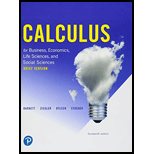
Concept explainers
Work all of the problems in this self-test without using a calculator. Then check your work by consulting the answers in the back of the book. Where weaknesses show up, use the reference that follows each answer to find the section in the test that provides the necessary review.
1. Replace each question mark with an appropriate expression that will illustrate the use of the indicated real number property:
(A) Commutative (·): x(y + z) = ?
(B) Associative (+): 2 + (x + y) = ?
(C) Distributive: (2 + 3)x = ?
(A)
To find: The equivalent expression of
Answer to Problem 1E
The expression
Explanation of Solution
Given:
The expression is
Property used:
Commutative property:
“The order of factors does not affect the result of expression”.
That is, if x commutes with y under the operation
Illustration:
The factors of the given expression
Apply the commutative property by changing the order of factors to obtain the required equivalent expression.
That is,
Therefore, the expression
(B)
To find: The equivalent expression of
Answer to Problem 1E
The expression
Explanation of Solution
Given:
The expression is
Property used:
Associative property:
The grouping of any two numbers in an expression which contains more than two terms does affect the resulting expression.
That is, the property of associative under “
Illustration:
Apply the associative property by changing the group of terms to obtain the required equivalent expression.
That is,
Therefore, the expression of
(C)
To find: The equivalent expression of
Answer to Problem 1E
The expression
Explanation of Solution
Given:
The expression is
Property used:
Distributive property:
The property of left distributive under multiplication over addition state that
Illustration:
Apply the left distributive property under multiplication over addition to obtain the required equivalent expression.
That is,
Hence, the expression of
Want to see more full solutions like this?
Chapter DPT Solutions
Pearson eText for Calculus for Business, Economics, Life Sciences, and Social Sciences, Brief Version -- Instant Access (Pearson+)
Additional Math Textbook Solutions
Elementary Statistics: Picturing the World (7th Edition)
Thinking Mathematically (6th Edition)
A First Course in Probability (10th Edition)
Algebra and Trigonometry (6th Edition)
University Calculus: Early Transcendentals (4th Edition)
A Problem Solving Approach To Mathematics For Elementary School Teachers (13th Edition)
- 1. One of the partial fractions for 2 4x²+x-9 x3+2x²-3x 2 x+1 a) x23 b) x 1½ c) x² d) x-1 x isarrow_forward1. One of the partial fractions for 2 2 4x²+x-9 x3+2x²-3x a) x3 b) x11 c) x² d) z x-1 2. Identify the improper integral. 1 x 2 x dx a) 3x dx b) f² 3x dx 0 3-2x 0 3-2x x is c) √2^: 4 √232x dx d) fo² 3x dx 1 1 0 3-2x B. So eax dx converges to if : a) O if a0 c) - 1½ ifa 0arrow_forwardComplete the square and find the indefinite integral. (Remember to use absolute values where appropriate. Use C for the constant of integration.) dx x²-12x+27arrow_forward
- Complete the table. Enter DNE if a quantity doesn't exist or NEI if not enough information is given. f(c) limx-->c- f(x) limx-->c+ f(x) limx -->c f(x) continuity at x=c 2 4arrow_forwardFind the indefinite integral. (Use C for the constant of integration.) 9x arcsin(x) dxarrow_forwardFind the indefinite integral using the substitution x = 5 sin(e). (Use C for the constant of integration.) 1 dx (25-x²)3/2arrow_forward
- Find the indefinite integral using the substitution x = 7 sec(0). (Use C for the constant of integration.) √ ׳ √x² - 49 dxarrow_forwardUse the Cauchy Riemann equations (polar form version). Also, describe what happens at the branch cut.arrow_forwardb. i. Show that the following matrix is orthogonal. A = ドードー ii Find the inverse of matrix A. Show all working in an organized/orderly manner. 2 3 -619 A = 42 3 1 5 B-1127) a. Given D = , decode the following message: 32, 24, 42, 28, 24, 40, 50, 60, 132, 96, 12, 24arrow_forward
- 2 Graph of h 6. The graph of the function h is given in the xy-plane. Which of the following statements is correct? , the graph of h is increasing at an increasing rate. (A) For (B) For (C) For 苏|4 K|4 π π , the graph of h is increasing at a decreasing rate. 2 0 and b>1 (B) a>0 and 01 (D) a<0 and 0arrow_forwardQUESTION 4 Peter says that the following expressions can be simplified into one trigonometric ratio without the use of a calculator. Prove that Peter is correct by simplifying the following expressions into one trigonometric ratio: 4.1 sin 43° + sin 17º (5)arrow_forward3. Consider the sequences of functions fn: [-T, π] → R, sin(n²x) n(2) n (i) Find a function f : [-T, π] R such that fnf pointwise as n∞. Further, show that f uniformly on [-T,π] as n→ ∞. [20 Marks] (ii) Does the sequence of derivatives f(x) has a pointwise limit on [-7,π]? Justify your answer. [10 Marks]arrow_forwardarrow_back_iosSEE MORE QUESTIONSarrow_forward_ios
 Elementary AlgebraAlgebraISBN:9780998625713Author:Lynn Marecek, MaryAnne Anthony-SmithPublisher:OpenStax - Rice University
Elementary AlgebraAlgebraISBN:9780998625713Author:Lynn Marecek, MaryAnne Anthony-SmithPublisher:OpenStax - Rice University Mathematics For Machine TechnologyAdvanced MathISBN:9781337798310Author:Peterson, John.Publisher:Cengage Learning,
Mathematics For Machine TechnologyAdvanced MathISBN:9781337798310Author:Peterson, John.Publisher:Cengage Learning, Algebra: Structure And Method, Book 1AlgebraISBN:9780395977224Author:Richard G. Brown, Mary P. Dolciani, Robert H. Sorgenfrey, William L. ColePublisher:McDougal Littell
Algebra: Structure And Method, Book 1AlgebraISBN:9780395977224Author:Richard G. Brown, Mary P. Dolciani, Robert H. Sorgenfrey, William L. ColePublisher:McDougal Littell
 Glencoe Algebra 1, Student Edition, 9780079039897...AlgebraISBN:9780079039897Author:CarterPublisher:McGraw Hill
Glencoe Algebra 1, Student Edition, 9780079039897...AlgebraISBN:9780079039897Author:CarterPublisher:McGraw Hill College AlgebraAlgebraISBN:9781305115545Author:James Stewart, Lothar Redlin, Saleem WatsonPublisher:Cengage Learning
College AlgebraAlgebraISBN:9781305115545Author:James Stewart, Lothar Redlin, Saleem WatsonPublisher:Cengage Learning





